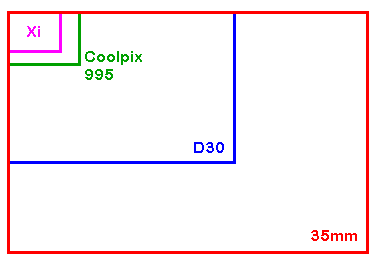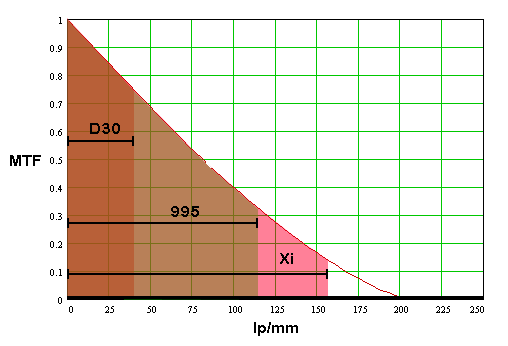
|
Digital Sensor Size - Why Size MattersThere's a lot of attention paid in the digital camera world to pixel count. Cameras are often categorized by the number of pixels they have in their image sensor. However not all pixels are equal and, as in many contexts, size matters! In this article I'm going to take a look at several digital cameras with different physical sensor sizes but all with a nominal 3 megapixel (3MP) pixel count. A standard 35mm frame is 36mm x 24mm, so lets call that "full frame". As you can see from row #1 in the table, all the cameras listed here have sensors smaller than a "full frame sensor". Just looking at the "short" side of the sensor compared to the "short" side of the 35mm frame we can see that the Canon D30 sensor (which is the same size as the sensor in the EOS D60, 10D, 300D and 20D) is 0.63x full frame, the Nikon Coolpix 995 0.22x full frame and the Minolta Xi sensor is 0.167x full frame. You can see the difference in relative sensor size from the figure below. It's pretty dramatic!
"So what" you might think, "if you have enough pixels, what does the sensor size matter?". Cameras with smaller sensors use shorter focal length lenses to get the same angular coverage as cameras with larger sensors do with longer focal length lenses. So if you have a 28-105mm zoom on a Canon D30, a 10-37mm zoom on a Nikon 995 or a 7.4-28mm zoom on a Minolta Xi, you get approximately the same shot. What's the big deal about the physical size of the sensor? Why does it matter? One reason why sensor size matters is shown in the table below which I'll go though line by line since it's a little complex! Please note that the numbers are intended only for illustrative purposes and in some cases may be approximations or upper limits. These numbers are not intended to be accurate predictions of the exact resolution you would see from these cameras in practice. However the trends which these numbers illustrate certainly can be seen!
OK, so those are the basic facts. Now lets take an example of an 8x10 print and let's say we want a fairly sharp print, so we are going to need a resolution of at least 3 lp/mm in the print. First, by looking at line 7 we can see that that's possible with all three cameras. Now for 3 lp/mm in the print, what resolution do we need from the sensor? Well, that's given in row #8 of the table. Since the smaller the sensor the more the image needs to be enlarged, to get the same resolution in the same sized print we need more resolution from smaller sensors. The table shows that for the D30 we need to record the image at up to 40.4 lp/mm on the sensor. For the Coolpix 995 we need to record 115 lp/mm on the sensor and for the Xi we need to record a whopping 152.4 lp/mm on the sensor. Now we get to MTF (Modulation Transfer Function). This is a measure of lens performance and shows how well a lens reproduces object detail in the image it produces. I'll deal with MTF and exactly what it is in a future article, but for now it's enough to know that MTF can range from 1 to 0, and that high numbers mean high contrast, resolution and image fidelity, while lower numbers mean lower contrast, resolution and image fidelity. You want high numbers! Line 9 of the table shows the MTF of a perfect lens operating at f8 when recording detail on the sensor at the resolution given in line 8 of the table. So for the D30, we need 40.4 lp/mm on the sensor, and at 40.4 lp/mm a lens operating at f8 will have an MTF of 0.75. For the Coolpix 995 we need 115 lp/mm on the sensor, and at 115 lp/mm a lens operating at f8 will have an MTF of 0.31. Finally for the Xi we need 152.4 lp/mm on the sensor to get 3 lp/mm in an 8x10 print, and at 152.4 lp/mm an f8 lens has an MTF of 0.14. Lines 10 and 11 show the corresponding numbers for a perfect lens at f4 and f2. The larger sensor is still better, but the difference is less pronounced. Note however that the data here is the best possible case. In practice lenses are not perfect and the faster a lens is, the less perfect it is. Real MTF drops off much faster than that predicted for a perfect lens, so the differences in MTF between sensor sizes will actually be greater than the analysis here shows, especially at wide apertures, giving an even greater advantage to the larger sensors. So its clear that the larger the sensor, the higher up on the MTF curve of the lens it's operating at when delivering a particular resolution and the final output is a print of a given size. This is shown graphically in the figure below.
This graph shows where on the lens' MTF curve each of the 3 cameras operate when at f8 and used to make an 8x10 print with detail up to 3 lp/mm in the print. As you can see the D30 uses the high part of the MTF curve and so yields an image of good contrast and resolution all the way up the the required 3 lp/mm. The Coolpix 995 with a significantly smaller sensor has to use part of the MTF curve which is lower than that used by the D30, and the Xi with the smallest sensor of all has to use almost the whole MTF curve, even the low part. The range of the curve used depends only on the size of the sensor, so we could replace the "D30" label with 22.7mm x 15.1mm, the "995" label with 7.2mm x 5.3mm and the "Xi" label with 5.3mm x 4mm. Since all three of these cameras are nominal "3MP" cameras, we can predict that results from the D30 will be better than those from the Coolpix 995, which will in turn be better than those from the Xi, assuming we use a lens of the same optical quality on each camera. One final interesting point is shown by row 12 of the table which shows the MTF at f16. The D30 sensor is OK but using the 995 sensor or the Xi sensor the MTF is zero! What this means is that there would be a significant drop in image quality operating at f16 with either the Coolpix 995 or the Xi. In fact we could not obtain the desired 3 lp/mm in an 8x10 print if we were able to stop the lens down to f16 on those camera. That's why the smallest aperture available on these and most other small sensor cameras is f8. So now you know why "bigger is better" when it comes to image quality and digital sensors. Of course bigger is also more expensive, and bigger means bigger (hence heavier and more expensive) lenses, so you can see why many digital cameras stick with small sensors. It's cost, not quality that keeps sensors small. © Copyright Bob Atkins All Rights Reservedwww.bobatkins.com |
||||||||||||||||||||||||||||||||||||||||||||||||||||||||||||||||||||||||||||
|
|||||||||||||||||||||||||||||||||||||||||||||||||||||||||||||||||||||||||||||







